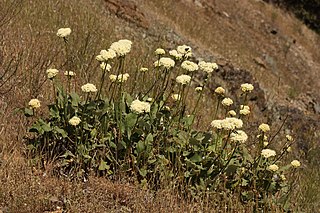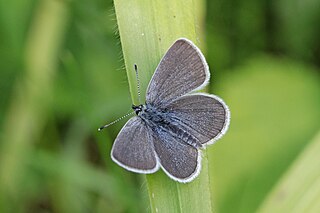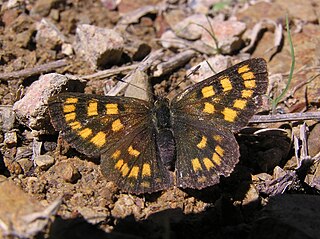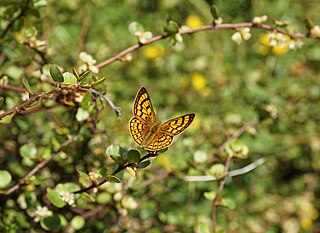
The large blue is a species of butterfly in the family Lycaenidae. The species was first defined in 1758 and first recorded in Britain in 1795. In 1979 the species became mostly extinct in Britain but has been successfully reintroduced with new conservation methods. The species is classified as "near threatened" on the IUCN Red List of Threatened Species. Today P. arion can be found in Europe, the Caucasus, Armenia, western Siberia, Altai, north-western Kazakhstan and Sichuan.

Pieris rapae is a small- to medium-sized butterfly species of the whites-and-yellows family Pieridae. It is known in Europe as the small white, in North America as the cabbage white or cabbage butterfly, on several continents as the small cabbage white, and in New Zealand as the white butterfly. The butterfly is recognizable by its white color with small black dots on its wings, and it can be distinguished from P. brassicae by its larger size and the black band at the tip of its forewings.

The common blue butterfly or European common blue is a butterfly in the family Lycaenidae and subfamily Polyommatinae. The butterfly is found throughout the Palearctic and has been introduced to North America. Butterflies in the Polyommatinae are collectively called blues, from the coloring of the wings. Common blue males usually have wings that are blue above with a black-brown border and a white fringe. The females are usually brown above with a blue dusting and orange spots.

Eriogonum is a genus of flowering plants in the family Polygonaceae. The genus is found in North America and is known as wild buckwheat. This is a highly species-rich genus, and indications are that active speciation is continuing. It includes some common wildflowers such as the California buckwheat.

Lycaenidae is the second-largest family of butterflies, with over 6,000 species worldwide, whose members are also called gossamer-winged butterflies. They constitute about 30% of the known butterfly species.

Lycaena phlaeas, the small copper, American copper, or common copper, is a butterfly of the Lycaenids or gossamer-winged butterfly family. According to Guppy and Shepard (2001), its specific name phlaeas is said to be derived either from the Greek φλέγω (phlégo), "to burn up", or from the Latin floreo, "to flourish".

The large copper is a butterfly of the family Lycaenidae. L. dispar has been commonly arranged into three subspecies: L. dispar dispar, (single-brooded) which was commonly found in England, but is now extinct, L. d. batavus, (single-brooded) can be found in the Netherlands and has unsuccessfully been reintroduced into the United Kingdom, and lastly, L. d. rutilus, (double-brooded) which is widespread across central and southern Europe. The latter has been declining in many European countries, due to habitat loss. Currently L. dispar is in severe decline in northwest Europe, but expanding in central and northern Europe.

The small blue is a Palearctic butterfly in the family Lycaenidae. Despite its common name, it is not particularly blue. The male has some bluish suffusion at the base of its upper wings but is mostly dark brown like the female. The species can live in colonies of up to several hundred and in its caterpillar stage is cannibalistic.

The queen butterfly is a North and South American butterfly in the family Nymphalidae with a wingspan of 80–85 mm. It is orange or brown with black wing borders and small white forewing spots on its dorsal wing surface, and reddish ventral wing surface fairly similar to the dorsal surface. The ventral hindwings have black veins and small white spots in a black border. The male has a black androconial scent patch on its dorsal hindwings. It can be found in meadows, fields, marshes, deserts, and at the edges of forests.

The purple-shot copper is a butterfly in the family of the Lycaenidae or copper butterflies and in the genus of the Lycaena.

The scarce copper is a butterfly of the family Lycaenidae.

The purple-edged copper is a butterfly of the family Lycaenidae.

Lycaena dorcas is a species of butterfly in the family Lycaenidae, the gossamer-winged butterflies. Its common names include dorcas copper and cinquefoil copper. The species was first described by William Kirby in 1837. It is native to North America. The species L. dospassosi was once included in L. dorcas.

Lycaena epixanthe, also known as the bog copper or cranberry-bog copper, is a North American species of butterfly in the family Lycaenidae. Adults like to sip drops of dew clinging to leaves and almost exclusively nectar on their host plant, cranberries. Because of this, bog coppers will spend their entire lives within the area of a single acid bog. Even though their flight is weak and close to the ground, bog coppers are hard to catch because of the habitat in which they live. Also, 85% of the bog coppers life span is spent in the egg. It is listed as a species of special concern in the US state of Connecticut.

Lycaena feredayi, the glade copper, is a butterfly of the family Lycaenidae. It is endemic to New Zealand.

The bright copper is a butterfly belonging to the family Lycaenidae.

Callophrys sheridanii, the Sheridan's hairstreak and Sheridan's green hairstreak, is a butterfly in the family Lycaenidae. It is found in North America along the south coast of British Columbia and parts of Nevada, Arizona, Saskatchewan, North Dakota, and New Mexico. In 2009, this species was adopted as the U.S. state butterfly for Wyoming.

Lycaena rubidus, the ruddy copper, is a butterfly of the family Lycaenidae. It is found in the western mountains of North America. Adults lay their eggs on plants of the genus Rumex, which later become the larval food plants. This butterfly gets its name from the brightly colored wings of the males, which are important in sexual selection. Its larvae exhibit mutualism with red ants, and are often raised in ant nests until they reach adulthood. Adults are on wing from mid-July to early August.

Lycaena boldenarum, the boulder copper, is a species of butterfly which is endemic to New Zealand, it is found on both North Island and South Island in a wide variety of open habitats including grassland, shingle and sand dunes. They are normally only active in bright sunny conditions and their flight is usually low to the ground. The boldenarum part of the species name given by the Scottish entomologist Adam White in honour of his first wife, Helen and her sister Frances, whose maiden name was Bolden. It shares the Maori name pepe para riki with two congeners the common copper and the glade copper.

Lycaena rauparaha, Rauparaha's copper, Fereday’s copper or mokarakare is a species of butterfly endemic to New Zealand. It acquired its English common name because it occurred in the same coastal areas as the rangatira (chief) and war leader of Ngāti Toa Maori, Te Rauparaha.




















